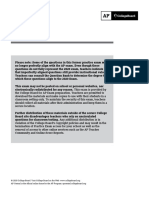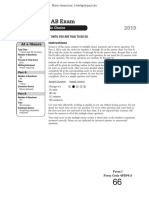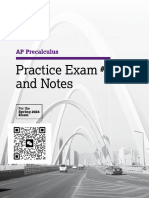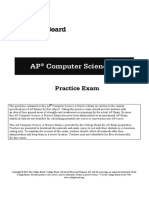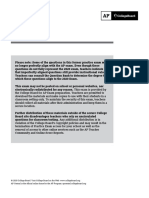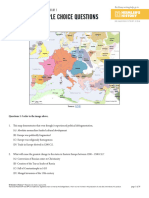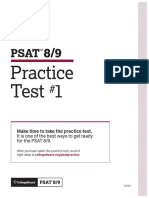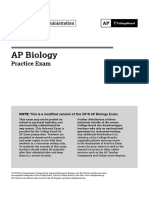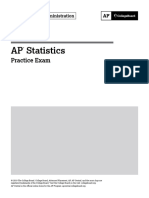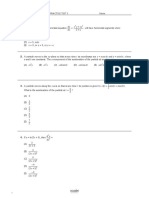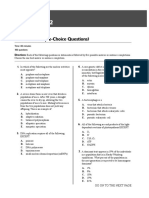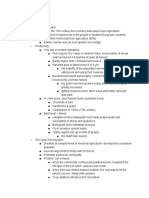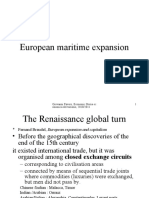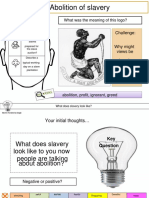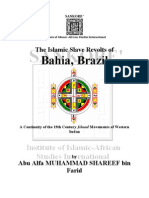Professional Documents
Culture Documents
Ap World History 2020 Practice Exam 2 MCQ Preview 2 PDF
Ap World History 2020 Practice Exam 2 MCQ Preview 2 PDF
Uploaded by
Roy HuOriginal Title
Copyright
Available Formats
Share this document
Did you find this document useful?
Is this content inappropriate?
Report this DocumentCopyright:
Available Formats
Ap World History 2020 Practice Exam 2 MCQ Preview 2 PDF
Ap World History 2020 Practice Exam 2 MCQ Preview 2 PDF
Uploaded by
Roy HuCopyright:
Available Formats
Practice Exam
Exam Content and Format
The AP World History: Modern Exam is 3 hours and 15 minutes long. There are
two sections:
• Section I is 1 hour, 35 minutes and consists of 55 multiple-choice questions,
accounting for 40 percent of the final score, and four short-answer questions,
accounting for 20 percent of the final score. Two short-answer questions
are mandatory and students can choose which of the remaining two short-
answer questions they respond to.
• Section II is 1 hour, 40 minutes and consists of one document-based question
and three long essay questions, accounting for 40 percent of the final score.
Students can choose which of the three long essay questions they respond to.
w
Students are given a 15-minute reading period and recommended time of
45 minutes of writing time for the document-based question and 40 minutes
for the long essay question, but students are not forced to move from the
document-based question to the long essay question.
ie
Administering the Practice Exam
This section contains instructions for administering the AP World History:
Modern Practice Exam. You may wish to use these instructions to create an
ev
exam situation that resembles an actual administration. If so, read the indented,
boldface directions to the students; all other instructions are for administering
the exam and need not be read aloud. Before beginning testing, have all exam
materials ready for distribution. These include test booklets and answer sheets.
(Reminder: Final instructions for every AP Exam are published in the AP Exam
Instructions book.)
Pr
SECTION I, Part A: Multiple Choice
When you are ready to begin Section I, Part A, say:
Section I, Part A is the multiple-choice portion of the exam. Mark all
of your responses on your answer sheet, one response per question. If
you need to erase, do so carefully and completely. Your score on the
multiple-choice section will be based solely on the number of questions
answered correctly.
You have 55 minutes for this part. Open your Section I booklet and
begin.
Note Start Time here ________. Note Stop Time here ________.
4 AP World History: Modern Practice Exam
Name:
AP® World History: Modern
Answer Sheet
for Multiple-Choice Section
No. Answer No. Answer
1 29
2 30
3 31
4 32
5 33
w
6 34
7 35
8 36
9 37
10
11
12
13
ie 38
39
40
41
ev
14 42
15 43
16 44
17 45
18 46
Pr
19 47
20 48
21 49
22 50
23 51
24 52
25 53
26 54
27 55
28
AP World History: Modern Practice Exam 7
AP World History: Modern Exam
®
SECTION I, Part A: Multiple Choice
DO NOT OPEN THIS BOOKLET UNTIL YOU ARE TOLD TO DO SO.
Instructions
At a Glance
Section I, Part A of this exam contains 55 multiple-choice questions.
Time
55 minutes Indicate all of your answers to the multiple-choice questions on the multiple-choice answer
Number of Questions sheet. No credit will be given for anything written in this exam booklet, but you may use
55 the booklet for notes or scratch work.
Percent of Total Score
40% Use your time effectively, working as quickly as you can without losing accuracy. Do not
Writing Instrument spend too much time on any one question. Go on to other questions and come back to
w
Pencil required the ones you have not answered if you have time. It is not expected that everyone will
know the answers to all of the multiple-choice questions.
Your total score on the multiple-choice section is based only on the number of questions
answered correctly. Points are not deducted for incorrect answers or unanswered
questions.
ie
ev
SECTION I, Part B: Short Answer
Instructions
At a Glance
For Section I, Part B of this exam, answer Question 1 and Question 2 and either
Time Question 3 or Question 4. Write your responses in the corresponding boxes on the
40 minutes short-answer response sheets. You must write your response to each question on
Number of Questions the lined page designated for that response. Each response is expected to fit within
3
Pr
its designated page. Fill in the circle on the Section I, Part B: Short-Answer
Percent of Total Score Response page indicating whether you answered Question 3 or Question 4.
20%
Writing Instrument
Pen with black or dark
blue ink
Questions 1 and 2
Mandatory
Question 3 or 4
Choose One Question
8 AP World History: Modern Practice Exam
w
The inclusion of source material in this exam is not intended
as an endorsement by the College Board or ETS of the content,
ideas, or values expressed in the material. The material has been
selected by the World history faculty who serve on the AP
ie
World History Development Committee. In their judgment,
the material printed here reflects various aspects of the course of
study on which this exam is based and is therefore appropriate to
use to measure the skills and knowledge of this course.
ev
Pr
AP World History: Modern Practice Exam 9
WORLD HISTORY: MODERN
SECTION I, Part A
Time—55 minutes
55 Questions
Directions: Each of the questions or incomplete statements is followed by four suggested answers or completions.
Select the one that is best in each case and then enter the letter in the corresponding space on the answer sheet.
Source materials have been edited for the purpose of this exercise.
w
ie
ev
Pr
GO ON TO THE NEXT PAGE.
10 AP World History: Modern Practice Exam
Questions 1 - 3 refer to the passage below.
“[Under the Song dynasty], the number of men who were granted degrees [by passing the imperial
examinations] suddenly rose, indicating a similar rise in the number of candidates. This was made possible
by an increase in China’s productive power and the consequent accumulation of wealth. . . . A new class
appeared in China [under the Song], comparable to the middle class in early modern Europe. In China this
newly risen class concentrated hard on scholarship. . . .
In principle [the examination system] was open to all qualified applicants regardless of social background,
which made it unusually democratic. . . . But for a candidate to continue his studies without interruption for
such a long period required a measure of economic support that was simply not available to poor people. . . .
[Thus] the contention that the doors of the examination system were open to all applicants was an
exaggeration, of course. . . . [Yet] we must not lose sight of the historical context: the very idea that everyone
should be eligible for the examinations, regardless of family background or lineage, was incomparably
forward-looking in its day. . . . It is true that the examinations not only produced officials loyal to the state but
also, at times, resentful rejected applicants who opposed the system. Yet, when an old dynasty was replaced
w
by a new, the latter usually undertook an early revival of the examination system practically unchanged.”
Ichisada Miyazaki, historian, China’s Examination Hell, book published in
1963
ie
1. All of the following developments in Song
dynasty China were important factors in the
accumulation of wealth outlined in the first
paragraph EXCEPT
2. Which of the following statements from the
second paragraph most directly supports the
claim that the examination system strengthened
the Chinese states?
ev
(A) increased Chinese involvement in the (A) The statement that most successful
Indian Ocean trade candidates “required a measure of
economic support that was simply not
(B) an increase in agricultural production in
available to poor people”
China
(B) The statement that “when an old dynasty
(C) increased Chinese production of
was replaced by a new, the latter usually
manufactured goods
Pr
undertook an early revival of the
(D) an increase in technological innovations in examination system practically
China unchanged”
(C) The statement that “the examinations not
only produced officials loyal to the state
but also, at times, resentful rejected
applicants who opposed the system”
(D) The statement that “the very idea that
everyone should be eligible for the
examinations . . . was incomparably
forward-looking in its day”
GO ON TO THE NEXT PAGE.
AP World History: Modern Practice Exam 11
3. Which of the following best describes the
author’s claim about the Chinese examination
system in the second paragraph?
(A) The system provided limited but important
opportunities for social advancement in
Chinese society.
(B) The system strongly reinforced rigid class
distinctions between nobles and
commoners in Chinese society.
(C) By offering opportunities to female
scholars, the system elevated the prestige
of women in Chinese society.
(D) By encouraging conformism and
w
obedience, the system prevented efforts to
reform and modernize Chinese society in
the nineteenth century.
ie
ev
Pr
GO ON TO THE NEXT PAGE.
12 AP World History: Modern Practice Exam
Questions 4 - 7 refer to the map below.
w
ie
ev
4. Which of the following led most directly to the 5. Which of the following contributed most
development of the trading network on the map? directly to an increase in trade along the routes
Pr
on the map?
(A) The growth of trading cities on the Swahili
Coast (A) The expansion of empires such as Mali in
West Africa
(B) Innovations in transportation and
commercial technologies such as (B) The expansion of the Mongol Empire
caravanserai across Eurasia
(C) The overall decline in the trade of goods (C) The start of the Protestant Reformation in
along the Silk Roads western Europe
(D) The emergence of the trans-Atlantic slave (D) The completion of the Christian
trade in West Africa Reconquista of Spain
GO ON TO THE NEXT PAGE.
AP World History: Modern Practice Exam 13
6. The spread of which of the following religious 7. In the period after circa 1450, trade along the
traditions was most directly facilitated by trade routes shown on the map declined in large part
along the routes shown on the map? because of the
(A) Christianity (A) decrease in the demand for African
manufactured goods in Europe
(B) Buddhism
(B) collapse of European economies in the
(C) Islam
wake of the bubonic plague
(D) Judaism
(C) disruption caused by the adoption of new
gunpowder weapons
(D) increase of maritime trade along the
African coast
w
ie
ev
Pr
GO ON TO THE NEXT PAGE.
14 AP World History: Modern Practice Exam
Questions 8 - 12 refer to the passage below.
“Wila Uma, the Inca general, addressed the Spanish [conquistadors] with the following words: ‘What are you
doing to our ruler?* This is how you repay his good will? Did he not command all of his people to give you
tribute? Did he not give you a house filled with gold and silver? Did he not give you his servants to serve
you? What more can he give you now that you have imprisoned him? All the people of this land are so
distressed by your actions, because they have lost all they possess, and their distress leaves them no choice
but to hang themselves or risk everything by rebelling. Thus, I believe it would be best for you to release him
from this prison to lessen the grief of these people.’ . . .
*Manco Inca, a previous Inca ruler and father of Titu Cusi, whom the Spanish had imprisoned after
conquering the Inca capital of Cuzco in 1533
Titu Cusi, ruler of a regional Inca state established after the Spanish had
conquered the Inca Empire,
w
letter to the Spanish king detailing the abuses of the Spanish during the
conquest, 1570
8. The sentiments expressed by Wila Uma in the 10. The sentiments expressed in the passage most
ie
passage most clearly illustrate which of the
following aspects of the Inca state?
(A) The persistence of cultural diversity within
the empire
(B) The influence of technological innovation
directly indicate
(A) opposition to growing syncretic religions
(B) concerns about the spread of epidemic
diseases
ev
(C) frustration over the establishment of forced
in expanding the empire
labor systems
(C) The importance of the Inca ruler to the
(D) resistance to European colonial expansion
empire
and control
(D) The extensive territorial extent of the
empire 11. Which of the following most directly facilitated
the conquest alluded to in the passage?
Pr
9. Which of the following was the most important
long-term effect of the European acquisition of (A) Spanish control of the trans-Atlantic slave
the wealth and resources of the Americas, as trade
alluded to in the passage? (B) Spanish advantages over native American
populations in terms of technology and
(A) A lasting shift in the balance of trade
disease immunity
between Europe and Asia
(C) The completion of the reconquest of the
(B) The decline of feudalism in Europe
Iberian Peninsula
(C) A decrease in the influence of Christianity
(D) The establishment of a cash-crop
worldwide
plantation economy on some of the
(D) The end of Chinese maritime exploration islands in the in the Atlantic Ocean
in the Indian Ocean
GO ON TO THE NEXT PAGE.
AP World History: Modern Practice Exam 15
12. Which of the following is the most likely
purpose of Titu Cusi’s letter?
(A) To encourage rebellion among the subjects
of the Inca Empire
(B) To gain help from Christian missionaries in
completing the conversion of his subjects
(C) To characterize the Spanish conquest of the
Inca Empire as unjust and illegitimate
(D) To increase the political reach of the Inca
Empire to its pre-conquest borders
w
ie
ev
Pr
GO ON TO THE NEXT PAGE.
16 AP World History: Modern Practice Exam
Questions 13 - 15 refer to the image below.
LIU GUANDAO, YUAN DYNASTY CHINESE COURT PAINTER, WHILING AWAY THE SUMMER,
PAINTED SCROLL, CIRCA 1280
w
The Picture Art Collection / Alamy Stock Photo
ie
The image depicts a Chinese Confucian scholar and two female attendants.
ev
13. The image can best be used as a source of 14. Which of the following historical continuities is
information about the best reflected in the image?
(A) social prestige of established educated (A) Chinese art reflected European methods of
elites in Chinese society under Mongol painting.
rule
Pr
(B) Chinese art continued to emphasize
(B) influence of Christian missionaries in traditional subjects and styles.
Mongol-controlled China
(C) Chinese art incorporated elements of
(C) high status of wealthy merchants in Central Asian nomadic life.
traditional Chinese society
(D) Chinese art continued to stress the
(D) increased importance of Mongol Buddhism importance of technological innovation.
and shamanism on Chinese society under
Yuan rule
GO ON TO THE NEXT PAGE.
AP World History: Modern Practice Exam 17
15. In addition to China, the cultural tradition
alluded to in Liu Guandao’s painting strongly
influenced the society and culture of
(A) the Ottoman Empire
(B) India
(C) Persia
(D) Korea
w
ie
ev
Pr
GO ON TO THE NEXT PAGE.
18 AP World History: Modern Practice Exam
Questions 16 - 19 refer to the passage below.
“Many [Ottoman] Sunni religious scholars have labeled the Sufi whirling rituals* as ‘dancing,’ and have
pronounced them forbidden, branding those who approve of them as infidels. The Sufis counter that these
rituals are not dancing, arguing instead that they enliven the soul through a combination of music and
movement, which, they say, allows them to focus on the spiritual aspects of religion. The common people
flock to the Sufis, giving them offerings and gifts. Since their whirling rituals play a big part in their
popularity, they will not abandon these practices anytime soon. The Sunni scholars have written many tracts
and opinions against them . . . and this tug-of-war between the two parties has brought them into a vicious
circle.”
*religious observances practiced by some Sufis in the Ottoman Empire
Katip Çelebi, Ottoman official, The Balance of Truth, philosophical and
scientific treatise, 1656
w
16. Which of the following conclusions regarding 18. The author’s position on the religious
the Ottoman Empire is best supported by the controversy in the passage can best be described
passage? as that of
ie
(A) Ottoman policies sought to limit the
activities of some religious groups.
(B) Many members of the Ottoman religious
establishment practiced Sufism.
(A) a strong supporter of the official Ottoman
religious establishment
(B) an impartial observer describing the
controversy without taking sides
ev
(C) Ottoman rulers promoted an inclusive and (C) a practitioner of the Sufi way with its
tolerant interpretation of Islamic doctrine. emphasis on increased spirituality
(D) Ottoman policies toward Sufism caused (D) an advocate of the right of the people to
conflicts between the Ottoman Empire freely choose their own religion
and other Muslim states.
19. Outside of the Ottoman Empire, Sufis
17. Which of the following most directly contributed most directly to which of the
Pr
strengthened Sunni religious scholars’ role as following during the period before 1750?
official interpreters of Islamic doctrine within
the Ottoman Empire, as suggested by the (A) Scientific exchanges between the Muslim
passage? world and the rest of Afro-Eurasia
(B) The establishment of Arabic as the
(A) The establishment of the Mughal Empire
language of philosophy and theology in
in India
the Muslim world
(B) The Ottoman conquest of Constantinople
(C) The spread of Islam to new locations on
(C) Ottoman sultans’ extensive conquests in the margins of the Muslim world, such as
Europe southeast Asia
(D) The Ottoman Empire’s rivalry with the (D) The introduction of new practices for
Safavid Empire recruiting and training slave soldiers in
Muslim states, such as the Mughal
Empire
GO ON TO THE NEXT PAGE.
AP World History: Modern Practice Exam 19
Questions 20 - 23 refer to the image below.
JAPANESE FUMI-E (“STEPPING-ON PICTURE”), A TYPE OF METAL PLATE CARVED WITH
CHRISTIAN IMAGERY, USED BY THE JAPANESE GOVERNMENT TO IDENTIFY SUSPECTED
CHRISTIANS, CIRCA 1630
w
ie
ev
Pr
Heritage Images / Contributor
Japanese authorities required suspected Japanese Christians to tread on fumi-e plates based on the belief
that Christians would refuse to disrespect images of Jesus Christ and other Christian religious figures.
GO ON TO THE NEXT PAGE.
20 AP World History: Modern Practice Exam
20. The object shown in the image is best 22. In the late nineteenth century, Japanese attitudes
understood in the context of which of the toward European cultural influences changed as
following developments between 1450 and 1750 a direct result of
?
(A) Japan isolating its economy from trade
(A) The introduction of Chinese religious and with Western markets
cultural influences in Japan
(B) Japan enacting political reforms during the
(B) The fall of the Tokugawa Shogunate and Meiji Era
restoration of direct imperial rule
(C) Japan defeating China in the First
(C) The growth of Russian cultural influence Sino-Japanese War
in East Asia as a result of the Russian
(D) Japan extending its empire over most of
expansion into Siberia
Southeast Asia
(D) The influence of European merchants and
missionaries along Asian maritime trade 23. In which of the following regions between 1450
w
routes and 1750 was Christian missionary activity met
with the LEAST amount of resistance by
21. The use of objects such as the one shown in the non-European states?
image best illustrates which of the following
historical processes from 1450 to 1750 ? (A) The Americas
ie
(A) Some Asian states sought to limit foreign
encroachment in their internal affairs.
(B) Political leaders in Asia commissioned
works of art to legitimize their rule.
(B) The Middle East
(C) The Indian subcontinent
(D) Central Asia
ev
(C) Religious conversion by state rulers was
often followed by the mass conversion of
state populations.
(D) The territorial expansion of Asian
land-based empires limited European
influence in many parts of Asia.
Pr
GO ON TO THE NEXT PAGE.
AP World History: Modern Practice Exam 21
Questions 24 - 27 refer to the passage below.
“Last Will and Testament
I, Anna de São Jozé da Trindade, Roman Catholic since baptism, always firm in the faith of the Catholic
religion, declare the present Will in the following manner:
I declare that I was born on the Coast of Africa from where I was transported to the states of Brazil and the
city of Salvador in the state of Bahia where I have lived until the present. I was a slave of Theodozia Maria da
Cruz, who bought me as part of a parcel of slaves, and who freed me for the amount of one hundred
mil-réis,* which I gave her in cash. And as a freed woman I have enjoyed this same freedom without the
least opposition until the present time.
I declare that I was never married and always remained single. And in this state I had five children.
I declare that the goods I possess are the following: a slave by the name of Maria, whom I leave conditionally
w
freed for the amount of sixty mil-réis, to be paid to my granddaughter.
I also possess a group of two-story houses with shops at street level and a basement below with lodgings,
located on the Ladeira do Carmo, where I live on land belonging to me.”
*currency unit in colonial Brazil
ie Anna de São Jozé da Trindade, Afro-Brazilian woman, last will and
testament, 1823
ev
24. The passage best illustrates which of the 25. The passage best supports which of the
following features of colonial Latin American following statements?
history?
(A) A small number of women were able to
(A) Racial categories were used to divide acquire wealth and property on their own.
colonial societies.
(B) Slaves were permitted to maintain families
Pr
(B) Christian religious practices were shared of their own.
by many social groups.
(C) Women contributed to the family income
(C) Plantation agriculture dominated economic by weaving textiles.
production.
(D) Women were the legal heads of the
(D) Competition between European states household in most families.
influenced colonialism.
GO ON TO THE NEXT PAGE.
22 AP World History: Modern Practice Exam
26. As described in the passage, Anna da Trindade’s 27. Which of the following was the most significant
life differed from the typical experience of change in Latin American labor systems
newly arrived slaves in colonial Latin America between the time the document was produced
in that she was and 1900 ?
(A) transported to Brazil (A) Slavery was abolished in all Latin
American countries.
(B) baptized as a Christian
(B) Many Latin American countries
(C) born in Africa
industrialized.
(D) able to purchase her freedom
(C) Indentured servitude became the main
source of labor in most Latin American
countries.
(D) Most Latin American countries passed
laws limiting the labor of women and
w
children.
ie
ev
Pr
GO ON TO THE NEXT PAGE.
AP World History: Modern Practice Exam 23
Questions 28 - 31 refer to the passage below.
“Italy has 108 inhabitants per square kilometer. In proportion to its territory, only three countries in Europe
surpass Italy in population density: Belgium, the Netherlands, and Great Britain. Every year, 100,000 farmers
and agricultural laborers emigrate from Italy. Italy witnesses its place in the family of civilized nations
growing smaller and smaller as it looks on with fear for its political and economic future. In fact, during the
last eighty years the English-speaking population throughout the world has risen from 22 to 90 million; the
Russian-speaking population from 50 to 70; and so forth, down to the Spanish population who were
18 million and are now 39. On the other hand, the Italian-speaking population has only increased from 20 to
31 million. At first, our emigrants were spreading Italy’s language in foreign countries, but since then, their
sons and grandsons ended up forgetting the language of their fathers and forefathers.
Realizing that our mistakes have cost us so much in the past and continue to cost us today, I believe that it is
less secure and more expensive for our people to continue to try to eke out a living from barren land in Italy
than to establish a large and prosperous agricultural colony in Eritrea.*”
w
*an Italian colonial territory in northeast Africa
Ferdinando Martini, governor of the Italian colony of Eritrea, Concerning
Africa, 1897
ie
28. The perspective of the author in the first
paragraph can best be understood in the context
of which of the following nineteenth-century
developments?
29. The author’s statement that descendants of
Italian emigrants “ended up forgetting the
language of their fathers and forefathers” most
directly refers to which of the following aspects
ev
of nineteenth-century migration?
(A) The expansion of Catholicism in Africa
and the Americas (A) Some receiving societies attempted to limit
the flow of immigrants.
(B) The development of new military
technologies due to industrialization (B) Some colonial states applied theories of
Social Darwinism to establish racial
(C) Competition among European states for
preferences.
global power and influence
Pr
(C) Immigrants often adopted the dominant
(D) Increasing African immigration to Italy
culture of the state in receiving societies.
(D) Immigrants often maintained some aspects
of their religion within ethnic enclaves.
GO ON TO THE NEXT PAGE.
24 AP World History: Modern Practice Exam
30. Italian and German imperial presence in Africa 31. Martini’s argument in the second paragraph
were similar in that both countries most clearly refers to the late-nineteenth-century
belief that imperialism was a useful way to
(A) saw African colonies as secondary to their
interests in Asia (A) relieve overcrowding and land shortages in
European countries
(B) were newly unified nations that began
colonizing later than other European (B) secure raw materials for European factories
powers
(C) promote scientific and technological
(C) primarily used their colonies in Africa to progress
spread Christianity
(D) “civilize” native populations through social
(D) invested heavily in African infrastructure change
and economic development
w
ie
ev
Pr
GO ON TO THE NEXT PAGE.
AP World History: Modern Practice Exam 25
Questions 32 - 35 refer to the passage below.
“Although I am a common woman, I have been the head of a family for some time, and I have fulfilled the
various duties required as head of a family. Therefore, I automatically assumed that the government gave all
heads of families equal rights regardless of sex. However, I recently found that this is not the case. I was told
that I have no right to vote even for the local ward [neighborhood] assembly where I live because I am a
woman. I was also told that for the same reason I am unable to sign or co-sign legal documents, although I
have my registered legal seal. Thus there is a world of difference between male and female heads of families
in terms of rights. But rights and duties should coexist together. It should logically be the case that if the head
of family has the right to vote, she has an obligation to pay tax; but if there is no vote, there should be no tax
obligation. However, I have to pay tax even though I have no right to vote. Considering this, I feel that my
rights have been denied.”
Kusunose Kita, Japanese woman political activist and member of the
Popular Rights Movement, an organization that advocated expanding voting
w
rights in Japan, “Letter to the Government Authorities,” 1878
32. As described in the passage, the voting 34. Based on the passage, the author would most
requirements in Japan circa 1878 most directly likely support which of the following policies?
reflect the continuing influence of
ie
(A) societal norms that assigned women lower
status than the status of men
(B) nationalistic ideals that mobilized Japanese
(A) Adopting a socialist system of government
to reduce economic inequalities in
Japanese society
(B) Providing greater educational opportunities
ev
men to support imperial expansion to increase women’s economic
independence
(C) middle-class ideals that motivated women
to seek work outside the household (C) Industrializing the Japanese economy to
increase the standard of living for all
(D) Buddhist principles that emphasized the
Japanese citizens
spiritual equality of men and women
(D) Returning Japan’s political order to the
33. The author’s argument regarding taxation most way it was under the Tokugawa
Pr
closely resembles the arguments made by Shogunate
(A) Enlightenment thinkers regarding natural 35. The type of grievances outlined by the author in
rights and the social contract the passage was a key contributing factor in the
(B) working-class movements regarding better outbreak of which of the following?
wages and working conditions
(A) The American Revolution
(C) abolitionist movements regarding the need
(B) The Haitian Revolution
to end the Atlantic slave trade
(C) The First World War
(D) conservative thinkers regarding the need to
preserve the social status of landed elites (D) The Second World War
GO ON TO THE NEXT PAGE.
26 AP World History: Modern Practice Exam
Questions 36 - 39 refer to the image below.
INDIAN MUSLIM TROOPS IN THE BRITISH ARMED FORCES PRAYING. PHOTOGRAPH TAKEN
IN SURREY, ENGLAND, 1916
w
ie
ev
FPG / Staff
In the background, a group of British civilians, mostly women, are watching the troops pray.
Pr
36. The photograph best illustrates which aspect of 37. The experiences of soldiers such as those shown
population movements in the late nineteenth and in the photograph most likely contributed to
early twentieth centuries? which of the following developments after 1918
?
(A) They often involved the spread of cultural
traditions into new locations. (A) Conflict between Hindus and Muslims in
India
(B) They were often undertaken to displace
labor force lost to war or disease. (B) The rise of authoritarian governments
between the world wars
(C) They often resulted in the decline or
disappearance of native religious (C) The idea that all Muslims should unite
traditions. politically under the Ottoman sultan
(D) They often caused intercommunal (D) Growing anti-imperial opposition in
violence. European colonies such as India
GO ON TO THE NEXT PAGE.
AP World History: Modern Practice Exam 27
38. The situation shown in the image is best 39. As shown in the image, the deployment of
understood in the context of which of the soldiers by European powers most directly
following aspects of twentieth-century warfare? relates to which of the following causes of
conflict during the early twentieth century?
(A) States used propaganda to intensify
patriotism in times of war. (A) The network of rival alliance systems
(B) States used new industrial technologies to (B) Imperialist expansion and competition for
fight wars that were deadlier and more resources
expensive.
(C) The decline in global economic production
(C) States made full use of their populations and trade
and material resources to fight total wars.
(D) The emergence of revolutionary
(D) States increasingly mobilized their citizens communism
for warfare regardless of gender or class.
w
ie
ev
Pr
GO ON TO THE NEXT PAGE.
28 AP World History: Modern Practice Exam
Questions 40 - 43 refer to the table below.
ANNUAL REVENUES AND EXPENDITURES OF THE AFRICAN FRENCH COLONY OF TOGO, 1938
(in French francs)
Revenues
Direct taxes on the people 7,933,000
Taxes on domestic
22,870,000
production and imports
Revenue from postal
1,130,000
service and telegraph
Funds from the French
8,744,000
colonial budget
Other income 3,380,000
w
TOTAL 44,057,000
Expenditures
Colonial official salaries
ie
and other expenses
Public works,
communication and
infrastructure
Sleeping sickness-related
17,600,000
4,885,000
ev
personnel and other medical 2,700,000
costs
Other expenditures 15,259,000
TOTAL 40,444,000
The figures are from a report of the Togo colonial government to the Ministry of Colonies in Paris.
Pr
GO ON TO THE NEXT PAGE.
AP World History: Modern Practice Exam 29
40. The table best supports which of the following 42. The expenditures shown in the table most
conclusions? strongly illustrate which of the following?
(A) European powers did not provide financial (A) Despite some medical advances, the
support for the maintenance of their environment in Africa continued to
colonies. present unique challenges to European
imperialism.
(B) European powers maintained colonies
despite global war and economic (B) Despite economic challenges they faced at
depression. home, European imperial powers
continued to finance local manufacturing
(C) Europeans migrated and established settler
in their colonies.
communities in Africa.
(C) The primary objective of European
(D) Revenue from cash crops accounted for the
imperialism in Africa was to stop the rule
majority of “other income” in French
of private joint-stock companies.
African colonies.
w
(D) European colonial powers did not build
41. The revenues section of the table can best be roads, bridges, or railways in the African
used to illustrate which of the following territories under their control.
continuities between pre-1900 and post-1900
European imperialism? 43. Which of the following pieces of data from the
ie
(A) Competition between European colonial
powers encouraged imperial expansion.
(B) Some African peoples successfully resisted
colonial economic exploitation.
table most directly contradicts the claims of
European imperial powers that colonies existed
for the benefit of the colonized?
(A) Colonized peoples were expected to pay
taxes to support the colonial government.
ev
(C) Colonial powers directly subsidized most
(B) Expenditures on administrative salaries
of the expenditures needed to maintain
were far greater than what was spent on
their colonies.
public works and infrastructure.
(D) Colonial powers sought to extract wealth
(C) The colonial government received income
and economic resources from the
from the postal system and from
colonized peoples.
telegraph services.
Pr
(D) A significant portion of the colonial budget
was provided by the French government.
GO ON TO THE NEXT PAGE.
30 AP World History: Modern Practice Exam
Questions 44 - 46 refer to the two passages below.
Source 1:
“The British . . . have for many decades had settled notions about India’s future. Their concept of party
government and parliamentary rule has become the ideal with them as the best form of government for every
country. . . .
It is extremely difficult to appreciate why our Hindu friends fail to understand the real nature of Islam and
Hinduism. It is only a dream that the Hindus and Muslims can ever evolve a common nationality. This
misconception of one Indian nation will lead India to destruction if we fail to revise our notions in time. The
Hindus and Muslims in India belong to two different religious philosophies, social customs, literatures. . . .
They have different epics and different heroes. Very often the hero of one is a foe of the other. To yoke
together two such nations under a single state, one as a numerical minority and the other as a majority, must
lead to growing discontent and final destruction of any fabric that may be built up for the government of such
a state.”
w
Muhammad Ali Jinnah, leader of the All-India Muslim League, an
organization of Indian Muslims that had split from the Indian National
Congress, address to a meeting of the League, March 1940
Source 2:
ie
“We, the inhabitants of India, have one thing in common and that is our India-ness, which we share despite
our religious and cultural differences. Just as our different features and personalities do not affect our
common humanity, so our religious and cultural differences should not interfere with our shared association
ev
with our homeland. Therefore, like other religious groups in India, we Muslims have a duty to struggle for
the attainment of our common Indian interests and fight against the evils that hamper our common progress
and prosperity. This is what I mean when I speak of a common nationhood of all Indians. The [Indian
National] Congress, having the same position as ours, has made provisions for the protection of all religions,
cultures, and languages in a future Indian state.
On the other hand, the European concept of nationalism is unacceptable to our organization. We denounce it
and are totally against it.”
Pr
Husain Ahmad Madani, leader of the Council of Indian Muslim Religious
Scholars, address to the annual meeting of the organization, June 1940
GO ON TO THE NEXT PAGE.
AP World History: Modern Practice Exam 31
44. Taken together, the two sources best support 46. In the second half of the twentieth century, the
which of the following conclusions regarding kind of tensions illustrated by the two sources
the situation in British India in 1940? would most directly lead to the emergence of
which of the following in postcolonial Asian and
(A) The British skillfully manipulated religious African states?
tensions within India to rally support for
the imperial war effort. (A) Communist movements
(B) Indian opposition to British rule involved (B) Popular movements advocating the
groups pursuing very different political restoration of colonial rule
goals.
(C) Movements advocating for regional
(C) Indian Muslim religious scholars rejected autonomy
Gandhi’s emphasis on nonviolence to
(D) Famines and epidemics
achieve political change.
(D) There was a clear difference between
w
Hindu and Muslim visions of what
postwar India should be.
45. During the negotiations to end British rule in
India in the aftermath of the Second World War,
arguments?
ie
British actions were ultimately most strongly
influenced by which of the following
(A) The argument in Source 1 that, for the
British, “the concept of party government
ev
and parliamentary rule has become the
ideal . . . for every country”
(B) The argument in Source 1 that “to yoke
together two such nations under a single
state” would lead to “destruction”
(C) The argument in Source 2 that “religious
and cultural differences should not
Pr
interfere with [Indians’] shared
association with our homeland.”
(D) The argument in Source 2 that “the [Indian
National] Congress . . . has made
provisions for the protection of all
religions, cultures, and languages in a
future Indian state”
GO ON TO THE NEXT PAGE.
32 AP World History: Modern Practice Exam
Questions 47 - 51 refer to the graphs below.
Graph 1: Total Global Carbon Dioxide Emissions
w
ie
Graph 2: Share of Global Carbon Dioxide Emissions
ev
Pr
Graphs based on data from www.OurWorldInData.org
GO ON TO THE NEXT PAGE.
AP World History: Modern Practice Exam 33
47. The overall trend in global carbon dioxide 50. The trends for China and India in Graph 2 are
emissions as shown in Graph 1 was primarily best understood in the context of the
caused by the
(A) regional economic impact of the Great
(A) increased use of petroleum and other fossil Leap Forward on industrial production
fuels
(B) breakup of European colonial empires in
(B) destruction of rain forests and expansion of the aftermath of the Second World War
deserts
(C) shift of industrial production toward Asia
(C) development of genetically modified crops beginning in the late twentieth century
(D) proliferation of nuclear weapons (D) efforts of international financial
organizations to encourage greater
48. The trend in Graph 1 most directly led to which cooperation among countries
of the following?
51. Which of the following historical events best
w
(A) International efforts to help newly explains why, in the period 1990–2000, the
independent nations address air pollution trends in carbon dioxide production in the
in their major cities United States and in Russia diverge, as shown in
(B) Debates regarding the causes and extent of Graph 2 ?
humanity’s contributions to climate
change
ie
(C) Binding international commitments to
break up the big multinational energy
companies
(D) The growing popularity of nuclear power
(A) While the United States economy mostly
continued to grow, Russia’s economy
contracted following the collapse of the
Soviet Union.
(B) While the United States increased its
dependency on fossil fuels, Russia relied
ev
as an alternative energy source more on nuclear energy.
(C) While the United States experienced the
49. The environmental processes illustrated by the benefits of the Green Revolution, Russia
two graphs are most closely associated with experienced a decline in agricultural
production.
(A) An increase in biodiversity in many
regions (D) While the United States relied on imports
Pr
of oil and gas, Russia remained largely
(B) A decline in soil fertility rates in many
self-sufficient in energy production.
regions
(C) An increase in epidemic diseases in many
regions
(D) A decline in air and water quality in many
regions
GO ON TO THE NEXT PAGE.
34 AP World History: Modern Practice Exam
Questions 52 - 55 refer to the passage below.
1. Scientists have reached general agreement in recognizing that mankind is one: that all men belong to the
same species, Homo sapiens. . . .
10. The scientific material available to us at present does not justify the conclusion that inherited genetic
differences are a major factor in producing differences between the cultures and cultural achievements of
different peoples or groups. . . .
14. The biological fact of race and the myth of “race” should be distinguished. For all practical social
purposes “race” is not so much a biological phenomenon as a social myth. The myth of “race” has created an
enormous amount of human and social damage. In recent years it has taken a heavy toll in human lives and
caused untold suffering.
A. According to present knowledge there is no proof that the groups of mankind differ in their innate mental
characteristics, whether in respect of intelligence or temperament.
w
B. There is no evidence that race mixture as such produces bad results from the biological point of view.
C. All normal human beings are capable of learning to share in common life, to understand the nature of
mutual service and reciprocity, and to respect social obligations and contracts.
ie United Nations Educational, Scientific, and Cultural Organization
(UNESCO), statement about the “science of race,” 1949
ev
52. The declaration can best be understood as a 53. The declaration’s mention of a “heavy toll” in
rejection of which of the following ideals? the third paragraph was most likely a reference
to which of the following?
(A) The belief that some groups of people are
inherently superior to others (A) The casualties of the First World War
(B) The belief that all cultures have intrinsic (B) The deaths that occurred as a result of the
value use of nuclear weapons during the
Pr
Second World War
(C) The belief that race is a social construction
(C) The deaths that occurred during the
(D) The belief that the concept of race has had
Holocaust
a major impact on human interactions
(D) The mass violence that occurred under
communist leaders, such as Mao Zedong
GO ON TO THE NEXT PAGE.
AP World History: Modern Practice Exam 35
54. The declaration is an example of which of the 55. All of the following statements are factually
following post-Second World War accurate. Which would most directly support the
developments? claim in the first paragraph that “Scientists have
reached general agreement in recognizing that
(A) The creation of institutions to aid the mankind is one: that all men belong to the same
economic development of newly species, Homo sapiens”?
independent nations
(A) The declaration was signed in Paris, and
(B) An increase in international migration in
UNESCO was a specialized agency of the
search of economic opportunities
United Nations.
(C) The escalation of violence and proxy wars
(B) South Africa’s government withdrew from
between countries during the Cold War
UNESCO soon after the declaration on
(D) The efforts of international organizations race was adopted.
to promote human rights
(C) The declaration was signed by experts
from many countries with racially and
w
culturally diverse populations.
(D) The adoption of the declaration contributed
to debates in Western countries on the
question of race.
ie
ev
Pr
GO ON TO THE NEXT PAGE.
36 AP World History: Modern Practice Exam
You might also like
- Ap Precalculus 2023 Practice Exam 2 MCQDocument30 pagesAp Precalculus 2023 Practice Exam 2 MCQryzewu202467% (6)
- AP Physics 1 Practice Exam #3 For The 2022 Exam-1Document147 pagesAP Physics 1 Practice Exam #3 For The 2022 Exam-1Rishi Pandey100% (2)
- 2020 Practice Exam 1 PDFDocument24 pages2020 Practice Exam 1 PDFRama Rayyan100% (6)
- AP Bio 2017Document104 pagesAP Bio 2017H.Yu23No ratings yet
- 2016 AP English Language and Composition Practice Exam MCQ Multiple Choice Questions With Answers Advanced PlacementDocument63 pages2016 AP English Language and Composition Practice Exam MCQ Multiple Choice Questions With Answers Advanced Placementtabareka612No ratings yet
- Ap Computer Science Principles Practice Exam and Notes 2021Document108 pagesAp Computer Science Principles Practice Exam and Notes 2021Joseph Petersen100% (3)
- Ap Calculus Ab 2018 International Practice Exam FRQDocument20 pagesAp Calculus Ab 2018 International Practice Exam FRQJosh Albee50% (2)
- AP Calculus AB Exam: SECTION I: Multiple ChoiceDocument98 pagesAP Calculus AB Exam: SECTION I: Multiple ChoiceDrastic Pranksters Inc.100% (2)
- Etextbook 978 0393922097 Worlds Together Worlds Apart A History of The World From 1000 Ce To The Present Fourth Edition Vol 2Document62 pagesEtextbook 978 0393922097 Worlds Together Worlds Apart A History of The World From 1000 Ce To The Present Fourth Edition Vol 2elizabeth.myers417100% (50)
- 预备微积分2024参考试卷#1 学生Document52 pages预备微积分2024参考试卷#1 学生hqy1993goodNo ratings yet
- Ap Human Geography 2020 Practice Exam and Notes MCQDocument38 pagesAp Human Geography 2020 Practice Exam and Notes MCQChizitere OkorieNo ratings yet
- AP Calc BC 2017Document86 pagesAP Calc BC 2017thanhlqle123No ratings yet
- SG Unit2summativefrqDocument104 pagesSG Unit2summativefrq刘奇No ratings yet
- 2014 Ap Cs-ADocument59 pages2014 Ap Cs-AShroopNo ratings yet
- Ap Calculus Ab 2019 Practice Exam FRQDocument20 pagesAp Calculus Ab 2019 Practice Exam FRQJosh Albee0% (1)
- AP World History Modern Practice ExamDocument36 pagesAP World History Modern Practice Examlourdurajlinusjo4389100% (1)
- TB - APPhysics2 Resistance CapacitanceDocument29 pagesTB - APPhysics2 Resistance Capacitance平欣雨No ratings yet
- ACT Answer SheetDocument1 pageACT Answer SheetM_Tarek100% (1)
- Ap World History 2020 Practice Exam 1 MCQ PreviewDocument34 pagesAp World History 2020 Practice Exam 1 MCQ PreviewRoy HuNo ratings yet
- Ap Physics Dynamics FRQDocument12 pagesAp Physics Dynamics FRQEunseok ChoiNo ratings yet
- AP 2020 Physics Exam - Step 3 - Question 2Document5 pagesAP 2020 Physics Exam - Step 3 - Question 2Alex0% (1)
- PDF Psat-8-9-Practice-Test-2Document30 pagesPDF Psat-8-9-Practice-Test-2api-48944904125% (4)
- AP Calc BC 2019Document119 pagesAP Calc BC 2019Anish Dara100% (1)
- Exam 2020Document34 pagesExam 2020Sameh NoorNo ratings yet
- Slavery and IdentityDocument274 pagesSlavery and IdentityNubia SotiniNo ratings yet
- 202Document4 pages202Victor Miao50% (2)
- AP World 2014 Practice ExamDocument76 pagesAP World 2014 Practice ExamRay WanNo ratings yet
- 22-23 AP Language CompsitionDocument60 pages22-23 AP Language CompsitionFatoma AlnassirNo ratings yet
- Swim Your Ground Towards A Black and Blue HumanitiesDocument24 pagesSwim Your Ground Towards A Black and Blue HumanitiesJustin DunnavantNo ratings yet
- AP PhysicsB Practice Exam 2013 PDFDocument70 pagesAP PhysicsB Practice Exam 2013 PDFToni TonesNo ratings yet
- Quiz Apcspracticemultiplechoicetest2016Document31 pagesQuiz Apcspracticemultiplechoicetest2016api-255636511100% (1)
- AP World History 2007 MCDocument28 pagesAP World History 2007 MCKavi ShahNo ratings yet
- 2018 AP Calc. BC 2Document70 pages2018 AP Calc. BC 2ferhatyasarerginNo ratings yet
- AP Physics 1 Practice TestDocument9 pagesAP Physics 1 Practice TestJohn BoswellNo ratings yet
- AP Stats PracticesDocument28 pagesAP Stats PracticesSteven XuNo ratings yet
- Ap17 World History Practice Exam and NotesDocument170 pagesAp17 World History Practice Exam and NotesDerekEggenNo ratings yet
- Ap Biology 2020 Practice Exam 1 Scoring WorksheetDocument1 pageAp Biology 2020 Practice Exam 1 Scoring WorksheetkaylaNo ratings yet
- AP Biology 2008 Practice ExamDocument40 pagesAP Biology 2008 Practice ExamJ15100% (1)
- AP Physics 1 Practice Test 2Document18 pagesAP Physics 1 Practice Test 2John BoswellNo ratings yet
- AP Bio 2018 - Questions Only, Missing AnswersDocument81 pagesAP Bio 2018 - Questions Only, Missing Answersvancouver.taNo ratings yet
- APCS MCQ葵花宝Document67 pagesAPCS MCQ葵花宝xinpei zhouNo ratings yet
- TB LoopsandConditionalsPracticeTestDocument34 pagesTB LoopsandConditionalsPracticeTestemi dNo ratings yet
- AP Stat 2019 PracticeDocument140 pagesAP Stat 2019 PracticeLaura MesaNo ratings yet
- Practice Test 1 AP Calculus BC TPRDocument29 pagesPractice Test 1 AP Calculus BC TPRhmtNo ratings yet
- AP Calculus BC Practice TestDocument18 pagesAP Calculus BC Practice TestAnanyaNo ratings yet
- AP CalculusBC Practice Exam - 2012Document28 pagesAP CalculusBC Practice Exam - 2012tariniNo ratings yet
- AP Calc Exam 1Document10 pagesAP Calc Exam 1Jordan MilesNo ratings yet
- AP Physics 1 Practice Test 1 KEYDocument1 pageAP Physics 1 Practice Test 1 KEYMohamed MohamedNo ratings yet
- MC 3-26-2020Document12 pagesMC 3-26-2020api-43831616711% (9)
- AP Physics 1: Algebra-Based: Free-Response QuestionsDocument18 pagesAP Physics 1: Algebra-Based: Free-Response QuestionsAnitaNo ratings yet
- AP World Study Guide Pack NEW 04 2021Document19 pagesAP World Study Guide Pack NEW 04 2021LittlenessimsNo ratings yet
- Cracking Ap World History PT 5Document38 pagesCracking Ap World History PT 5api-406979573No ratings yet
- Broward County Schools AP Physics 1 ReviewDocument20 pagesBroward County Schools AP Physics 1 Reviewchris hemmainNo ratings yet
- 2019 Practice ExamDocument108 pages2019 Practice Exam1266No ratings yet
- SG Unit2progresscheckfrq 5e815f7aa64825Document7 pagesSG Unit2progresscheckfrq 5e815f7aa64825api-485795043No ratings yet
- AP 2020 Sample QuestionsDocument21 pagesAP 2020 Sample QuestionsZhaosheng TaoNo ratings yet
- BC Practice Test 3Document7 pagesBC Practice Test 3Tim JonesNo ratings yet
- Practice Test 2: Section I (Multiple-Choice Questions)Document27 pagesPractice Test 2: Section I (Multiple-Choice Questions)William Tac anNo ratings yet
- AP Calc Exam2Document25 pagesAP Calc Exam2Jordan Miles100% (1)
- AP Calculus Ab Things To Have Memorized3Document2 pagesAP Calculus Ab Things To Have Memorized3BahramNo ratings yet
- AP Biology: Free-Response QuestionsDocument13 pagesAP Biology: Free-Response QuestionsAnitaNo ratings yet
- APLANG - Mock Exam - MCQ - 2020 2Document29 pagesAPLANG - Mock Exam - MCQ - 2020 2r2cpq78998No ratings yet
- Chelsea House Publications Senegal DecDocument127 pagesChelsea House Publications Senegal Decidontlikeebooks100% (1)
- History Sba Notes 1Document5 pagesHistory Sba Notes 1MarcusAbrahamNo ratings yet
- Dwnload Full Enduring Vision A History of The American People 8th Edition Boyer Solutions Manual PDFDocument21 pagesDwnload Full Enduring Vision A History of The American People 8th Edition Boyer Solutions Manual PDFantonynolleus2645100% (16)
- AP Euro Chapter 19Document10 pagesAP Euro Chapter 19kim100% (1)
- f2 History Simplified Notes SPDocument40 pagesf2 History Simplified Notes SPmicah isaboke100% (2)
- History Study Guide TermsDocument5 pagesHistory Study Guide TermsdoriadNo ratings yet
- Study Guide Midterm Exam HIST 101 F18Document3 pagesStudy Guide Midterm Exam HIST 101 F18Abdul FaharNo ratings yet
- !2 European ExpansionDocument19 pages!2 European ExpansionSindhur GowravNo ratings yet
- Latino Muslims in The United States ReveDocument48 pagesLatino Muslims in The United States ReveArely MedinaNo ratings yet
- Republic of TogoDocument2 pagesRepublic of TogoFamzy buxNo ratings yet
- The Kongo Kingdom ReadingDocument6 pagesThe Kongo Kingdom Reading263321No ratings yet
- History of SlaveryDocument41 pagesHistory of SlaveryKerh Seker ShemsiNo ratings yet
- The French Revolution NotesDocument4 pagesThe French Revolution NotesSD PNo ratings yet
- Motives For Spanish and Portuguese Colonial ExpansionDocument9 pagesMotives For Spanish and Portuguese Colonial ExpansionGunjan MadanNo ratings yet
- Life in The ColoniesDocument43 pagesLife in The ColoniesurmomNo ratings yet
- The Igbo Tribe (What Makes Them Special)Document16 pagesThe Igbo Tribe (What Makes Them Special)Confidence ChikaNo ratings yet
- L3 - Abolition of The Slave TradeDocument13 pagesL3 - Abolition of The Slave Tradeyj songNo ratings yet
- Slave TradeDocument32 pagesSlave Tradeapi-269357456No ratings yet
- The Islamic Slave Revolts of BahiaDocument76 pagesThe Islamic Slave Revolts of BahiaAbuAbdur-RazzaqAl-MisriNo ratings yet
- Slavery British Country House WebDocument164 pagesSlavery British Country House WebBeatriz Breviglieri100% (4)
- Laumann (2013) Colonial Africa (1884-1994) 2Document11 pagesLaumann (2013) Colonial Africa (1884-1994) 2onyame3838No ratings yet
- The Slave Experience - ReligionDocument2 pagesThe Slave Experience - ReligionWhiteWorldNo ratings yet
- Vol3 Historical Perspectives of The NYABGDocument168 pagesVol3 Historical Perspectives of The NYABGropolsoNo ratings yet
- Tartarian Culture Black Moors and AllDocument14 pagesTartarian Culture Black Moors and AllRiza FahmiNo ratings yet
- His 310 AssignmentDocument19 pagesHis 310 AssignmentHalim Blessing EbubeNo ratings yet
- Ahuja ColonialismDocument15 pagesAhuja ColonialismGorgeous RCNo ratings yet
- Carey - Alcohol in The AtlanticDocument47 pagesCarey - Alcohol in The AtlanticDomingoGarciaNo ratings yet






